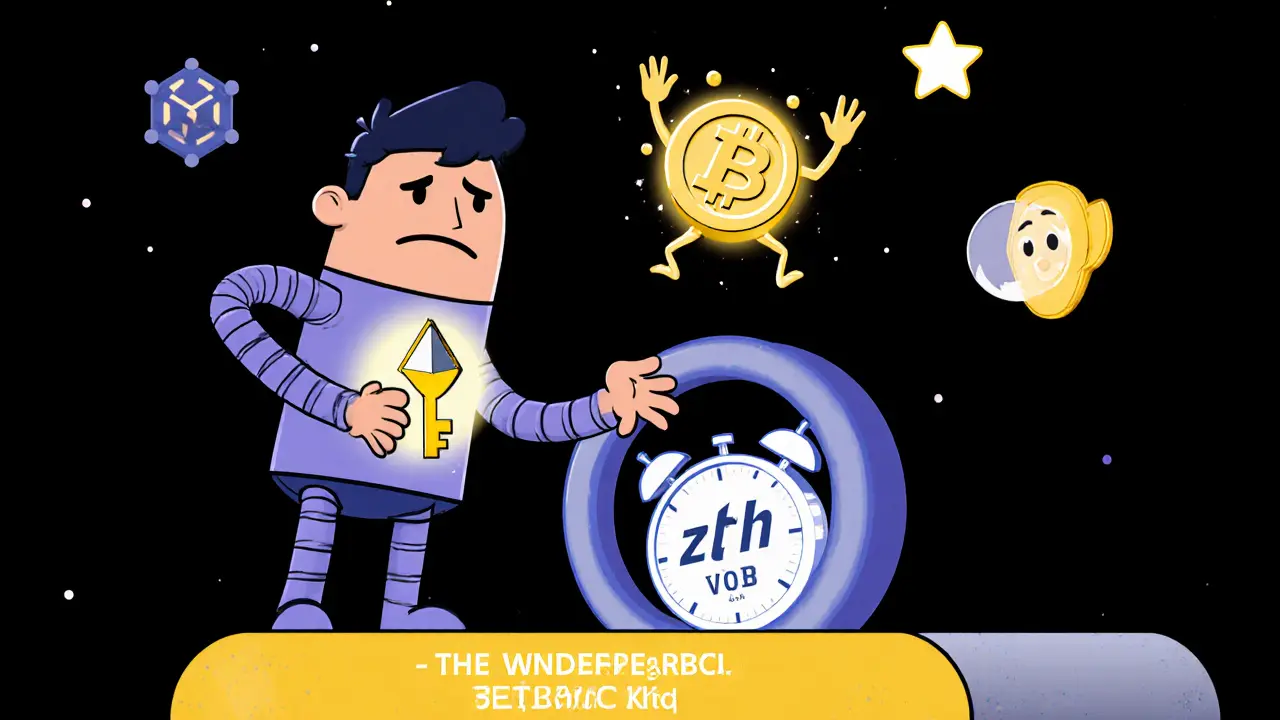Veno Finance Staking Calculator
Estimate Your Rewards
Current VNO Price
$0.01205
Estimated Daily Rewards
Total Rewards
VNO Tokens Earned
Total Value After Staking
Note: These are estimates based on industry averages. Actual returns may vary due to market conditions and protocol performance.
Most people think staking crypto means locking your coins away for weeks or months with no way to use them. But what if you could earn rewards and still trade, lend, or swap your staked assets? That’s where Veno Finance (VNO) comes in.
What Exactly Is Veno Finance?
Veno Finance is a decentralized liquid staking protocol that lets you stake cryptocurrencies like CRO, ATOM, and ETH - and get back liquid tokens that act like cash. Unlike traditional staking, where your tokens are frozen until the unbonding period ends, Veno gives you a liquid version of your staked asset. For example, if you stake 100 CRO, you get 100 LCRO (Liquid CRO). You can use LCRO in DeFi apps, trade it on exchanges, or even earn more rewards on top of your staking yield. All while your original CRO is still earning staking rewards behind the scenes. It launched in 2022 and was built specifically for the Cronos blockchain, which is part of the Cosmos ecosystem. But it didn’t stop there. In August 2023, Veno added support for zkSync Era, letting users stake ETH and get LETH - a liquid token that works across Ethereum Layer 2 apps. This multi-chain approach is rare. Most liquid staking platforms like Lido only focus on Ethereum. Veno targets users who want exposure to Cronos and Cosmos chains without giving up liquidity.How Does Veno Finance Work?
The system runs on three core components: the Reservoir, the Fountain, and the Veno Garden. These aren’t just fancy names - they’re functional parts of the protocol that distribute rewards.- The Reservoir: Lock your VNO tokens here and earn real yield from ATOM and WCRO rewards generated by the protocol’s staking operations.
- The Fountain: Deposit VNO to earn more VNO tokens as rewards. It’s like a self-sustaining reward loop.
- The Veno Garden: This rewards liquidity providers on partner DeFi platforms like Ferro and Tectonic. If you supply liquidity to these platforms, you get extra VNO tokens.
What Is the VNO Token For?
The VNO token isn’t just another coin. It’s the backbone of Veno’s economy. With a total supply of 1,844,674,055 tokens and a circulating supply of 474,514,554 as of October 2025, VNO is used for:- Governance: Holders can vote on protocol upgrades, fee structures, and new chain integrations.
- Yield generation: As shown in the Reservoir and Fountain, locking VNO earns you more VNO and other rewards.
- Protocol incentives: Veno Garden distributes VNO to users who support partner DeFi platforms.

Who Is Veno Finance For?
Veno isn’t for everyone. If you’re only interested in Ethereum and want the most trusted liquid staking solution, Lido is still the safer bet. Lido controls about 85% of the Ethereum liquid staking market. But if you’re active in the Cronos ecosystem - maybe you’re using Cronos-based DeFi apps, trading CRO, or holding ATOM from the Cosmos network - Veno is one of the few options that lets you stake without locking up your assets. It’s especially useful if you want to:- Stake CRO and still use it in Cronos DeFi protocols like Ferro or Tectonic.
- Stake ETH on zkSync Era and earn yield while using LETH in Layer 2 apps.
- Maximize returns by compounding staking rewards without paying gas fees every time.
Pros and Cons of Veno Finance
Pros
- Multi-chain support: Works on Cronos and zkSync Era - two fast-growing ecosystems.
- Auto-compounding: No need to claim rewards manually. Rewards compound automatically into your liquid token.
- High liquidity for staked assets: Use LCRO, LATOM, or LETH in DeFi, sell them, or use them as collateral.
- Strong user base: Over 17,000 stakers and $775,000 in total rewards paid out since launch.
Cons
- Low market cap and trading volume: VNO is illiquid. Large trades move the price.
- Limited transparency: No public audit reports from major firms. The team claims “enterprise-grade infrastructure,” but doesn’t name who audited it.
- Small ecosystem: Compared to Lido’s massive integration with wallets, exchanges, and DeFi apps, Veno is still small.
- Unbonding delays: You can’t instantly withdraw. You get an NFT and wait 21 days for ETH, for example.
How to Get Started With Veno Finance
Getting started takes less than 15 minutes if you’ve used a crypto wallet before.- Connect a wallet: MetaMask, Trust Wallet, or any EVM-compatible wallet works.
- Go to veno.finance and select your chain (Cronos or zkSync Era).
- Choose your asset: CRO, ATOM, or ETH.
- Enter the amount and click “Stake.” Confirm the transaction.
- Wait a few seconds. You’ll see your liquid token (LCRO, LATOM, or LETH) in your wallet.

Is Veno Finance Safe?
Safety is the biggest question. The team says they use “enterprise-grade staking infrastructure.” But they don’t name any audit firms, and there’s no public report you can read. That’s a red flag for some security experts. ZachXBT, a well-known blockchain investigator, has criticized protocols that make vague security claims without proof. That said, the protocol has been live since 2022, paid out over $775,000 in rewards, and hasn’t been hacked. The user base is growing steadily. The risk isn’t zero, but it’s lower than many new DeFi projects. If you’re risk-averse, don’t stake more than you’re willing to lose. Start small. Use only what you can afford to wait for 21 days to get back.Where Does Veno Finance Go From Here?
Veno’s roadmap includes adding more Cosmos chains like OSMO and JUNO. That’s smart. The Cosmos ecosystem is expanding fast, and Veno is one of the few liquid staking options there. Their move into zkSync Era shows they’re not just a Cronos project - they’re trying to become a cross-chain bridge for liquid staking. Delphi Digital noted in September 2023 that protocols enabling interoperability are “positioned for growth.” Veno fits that trend. But it needs to grow its TVL (total value locked) 40x to match the revenue of top competitors. That’s a huge challenge. Regulatory risk is also real. The SEC has cracked down on centralized staking services. Veno is decentralized, but if regulators start targeting liquid staking as a whole, it could affect everyone.Final Thoughts
Veno Finance (VNO) isn’t the biggest or most famous liquid staking protocol. But it’s one of the few that actually works well for users of Cronos and zkSync Era. If you’re already using those chains, it’s worth trying. The auto-compounding feature alone saves time and money. The user experience is clean, the rewards are real, and the team is active. But if you’re just looking for a safe, well-known way to stake ETH, stick with Lido. Veno is for the niche user - the one who wants to maximize yield across multiple chains without locking up their assets. For them, it’s one of the best options out there.If you’re curious, start with $50 in CRO. See how LCRO grows over a month. Try using it in Ferro. See if the rewards add up. You don’t need to go all in. But if you’re already in the Cronos ecosystem, Veno might be the missing piece you didn’t know you needed.

Comments (10)
Eddy Lust
November 28, 2025 AT 11:22
i've been using lcro in ferro for like 3 months now and honestly? it's been a game changer. no more manually claiming rewards, no gas fee headaches. just let it sit and watch the numbers creep up. i didn't even know i needed this until i tried it.
Casey Meehan
November 29, 2025 AT 06:11
this is 🔥🔥🔥 i’ve been waiting for someone to finally make liquid staking that actually works on cronos. lido is great but it’s like trying to use a Ferrari to drive through mud. veno? it’s the off-road truck of staking. 🚛💎
Tom MacDermott
November 29, 2025 AT 20:41
oh wow. another ‘revolutionary’ DeFi project that’s basically a glorified savings account with a fancy dashboard. the fact that you need to wait 21 days to get your ETH back is literally the definition of ‘illiquid’. congrats, you turned staking into a 3-week loan. 🙄
Martin Doyle
November 30, 2025 AT 06:13
you’re all missing the point. if you’re not using veno on zkSync, you’re leaving free yield on the table. the auto-compounding alone is worth more than the gas fees you’d burn trying to claim manually every week. this isn’t ‘niche’-it’s the future. stop clinging to lido like it’s the bible.
Susan Dugan
December 2, 2025 AT 00:14
i started with $50 in CRO like the post suggested and wow-just wow. my lcro balance went up 12% in 4 weeks without lifting a finger. i even used it as collateral on tectonic and got rewarded again. it’s like getting paid to sleep. if you’re on cronos, just do it. no regrets.
SARE Homes
December 2, 2025 AT 03:44
no audit? no transparency? no named security firm? you’re telling me you’re gonna stake your life savings into a black box called ‘enterprise-grade infrastructure’?!!?!!? this isn’t innovation-it’s gambling with a prettier UI. and the market cap? under $6M? HA. this is a rug pull waiting to happen.
Puspendu Roy Karmakar
December 2, 2025 AT 14:17
bro just try it. i’m from india, i don’t know all the fancy terms, but i staked 100 CRO and got LCRO. now i use it in ferro. rewards keep growing. easy. no stress. if you’re scared, start small. but don’t knock it till you try.
Evelyn Gu
December 3, 2025 AT 02:12
I just want to say-this whole concept of liquid staking is so brilliant, I mean, think about it: you’re not just earning passive income, you’re unlocking liquidity in a way that fundamentally changes how we interact with staked assets, and the fact that Veno integrates with both Cronos and zkSync Era? That’s not just clever, that’s visionary, and honestly, the auto-compounding feature? It’s like having a tiny financial assistant working 24/7 for you, and I’ve been watching my LETH grow every single day without ever having to click ‘claim’-it’s just... poetic, you know? Like digital alchemy.
Michael Fitzgibbon
December 3, 2025 AT 21:53
i’m not here to hype or trash. i just want to say: if you’re already in the cronos ecosystem, veno’s the quietest way to multiply your yield without drama. i’ve used lido, i’ve used others. this one doesn’t scream. it just works. and for me? that’s enough.
Tina Detelj
December 4, 2025 AT 14:57
the real question isn’t whether veno is safe-it’s whether we’re ready to accept that decentralization doesn’t mean perfection. lido’s big because it’s centralized in trust, not code. veno’s small because it’s trusting the code-and that’s terrifying, beautiful, and necessary. if we keep demanding audits from giants before we try anything new, we’ll never evolve. this isn’t just a protocol-it’s a philosophy.